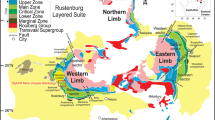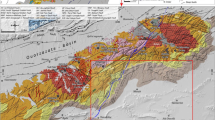Abstract
The Sylhet Traps and the larger outcrops of the Rajmahal Traps in India constitute an important remnant of a large Continental Flood Basalt (CFB) province related to the Kerguelen hotspot. A composite log of lava flows across the southern margin of the Meghalaya plateau is presented where the Sylhet Traps are best exposed. Lavas in the lower part of stratigraphic sequence (∼480 to 700 m above mean sea level) are compound and contain pahoehoe sheet lobes intruded by thin basaltic dykes constituting a swarm. These lavas record variable degrees of inflation at low effusive rates. In the upper parts, several rubbly pahoehoe lavas are interspersed with sheet lobes. These represent transitional lava types (between pahoehoe and aa) and occur due to steep gradients and/or increased effusive rates. The vesicles from within these lavas impinge and coalesce, indicating that they had time to form and grow in an insulated environment. The vesicle deformation index (VDI) ranges from 0.2 to 0.53, indicating moderate but variable shear strain on the lavas during emplacement. The coexistence of pahoehoe-rubbly pahoehoe lavas is also recorded in the surface outcrops of Rajmahal Traps and the IODP drill cores along the Kerguelen Plateau. It is postulated that the Sylhet lavas represent the distal edge of a lava-shield evolving into a flood basalt setting, dominated by pahoehoe in the lower stratigraphy with few lavas transitioning to rubbly pahoehoe towards the top. Such an architecture is in keeping with other CFB provinces worldwide.
Similar content being viewed by others
References
Baksi, A.K. (1995) Petrogenesis and timing of volcanism in the Rajmahal flood basalt province, northeast India. Chem. Geol., v.121, pp.73–90.
Baksi, A.K., Barman, T.R., Paul, D.K., Farrar, E. (1987) Widespread Early Cretaceous flood basalt volcanism in eastern India: geochemical data from the Rajmahal-Bengal-Sylhet traps. Chem. Geol., v.63(1–2), pp.133–141.
Bondre, N.R., Duraiswami, R.A., Dole, G. (2004) Morphology and emplacement of flows from the Deccan Volcanic Province, India. Bull. Volcanol., v.66(1), pp.29–45.
Das Gupta, A., Mukherjee, B. (2006) Geology of NW Bengal Basin. Geol. Soc. India, Bangalore, Publ., no.2(1), 154p.
Duraiswami, R.A., Bondre, N.R., Managave, S. (2008). Morphology of rubbly pahoehoe (simple) flows from the Deccan Volcanic Province: Implications for style of emplacement. Jour. Volcanol. Geotherm. Res., v. 177, pp.822–836.
Duraiswami, R.A., Gadpallu, P., Maskare, B., Purwant, A., Meena, P., Krishnamurthy, P., Mahabaleshwar, B. (2017) Volcanology and lava flow Morpho-types from the Koyna-Warna region, Western Deccan traps, India. Jour. Geol. Soc. India, v.90(6), pp.742–747.
Duraiswami, R.A., Gadpallu, P., Shaikh, T.N., Cardin, N. (2014) Pahoehoe—aa transitions in the lava flow fields of the western Deccan Traps, India-implications for emplacement dynamics, flood basalt architecture and volcanic stratigraphy. Jour. Asian Earth Sci., v.84, pp.146–166. doi:https://doi.org/10.1016/J.JSEAES.2013.08.025
Ghatak, A., Basu, A.R. (2011) Vestiges of the Kerguelen plume in the Sylhet Traps, northeastern India. Earth Planet. Sci. Lett. v.308(1–2), pp. 52–64.
Ghatak, A., Basu, A.R. (2006) Remnants of the Kerguelen plume in eastern India: evidence from Nd-Sr-Pb isotopic and trace element geochemistry of Sylhet Traps, Shillong Plateau. Amer. Geophys. Union v.87, p.52.
Ghose, N.C., Chatterjee, N., Windley, B.F. (2017). Subaqueous early eruptive phase of the late Aptian Rajmahal volcanism, India: Evidence from volcaniclastic rocks, bentonite, black shales, and oolite. Geosci. Front., v.8(4), pp.809–822.
Guilbaud, M.N., Self, S., Thordarson, T., Blake, S. (2005) Morphology, surface structures, and emplacement of lavas produced by Laki, AD 1783–1784. Geol. Soc. Am. Spec. Paper, v.396, pp. 81–102.
Hooper, P.R. (1990) The timing of crustal extension and the eruption of continental flood basalts. Nature, v.345, pp.246–249.
Islam, M.S., Meshesha, D., Shinjo, R. (2014) Mantle source characterization of Sylhet Traps, northeastern India: A petrological and geochemical study. Jour. Earth Sys. Sci., v.123(8), pp.1839–1855.
Jerram, D.A., Widdowson, M. (2005) The anatomy of Continental Flood Basalt Provinces: geological constraints on the processes and products of flood volcanism. Lithos, v.79(3–4), pp.385–405.
Katona, J., Fu, X., Mittal, T., Manga, M., Self, S. (2020) LIP flows may not have been as thick as they appear. Earth and Space Science Open Archive ESSOAr. doi:https://doi.org/10.1002/essoar.10507084.1
Katz, M.G., Cashman, K.V. (2003) Hawaiian lava flows in the third dimension: Identification and interpretation of pahoehoe and aa distribution in the KP 1 and SOH 4 cores. Geochem. Geophys. Geosys., v.4(2), 8705.
Kent, R.W., Pringle, M.S., Müller, R.D., Saunders, A.D., Ghose, N.C. (2002) 40Ar/39Ar geochronology of the Rajmahal basalts, India, and their relationship to the Kerguelen Plateau. Jour. Petrol., v.43(7), pp.1141–1153.
Keszthelyi, L.(2002). Classification of the mafic lava flows from ODP Leg 183. In: Frey FA, Coffin MF, Wallace PJ, Quality PG (Eds), Proceedings of the Ocean Drilling Program. Scientific Results, v. 183, pp.1–28.
Kilburn, C.R.J. (1981) Pahoehoe and aa lavas: a discussion and continuation of the model of Peterson and Tilling. Jour. Volcanol. Geotherm. Res., v.11, pp.373–382.
Krishnamurthy, V. and Duraiswami, R.A. (2022) Delineation of phreatic basaltic aquifers in the Upper Nira River Basin, India and evaluating the efficacy of methodologies used for estimating their groundwater potential — A case study. Geol. Soc. India, Spl. Publ., No.12, pp.247–259.
Macdonald, G.A. (1953) Pahoehoe, aa, and block lava. Amer. Jour. Sci. v.251, pp.169–191. doi:https://doi.org/10.2475/ajs.251.3.169
Monterio, A.J., Duraiswami, R.A., Mittal, T., Pujari, S.J., Low, U. and Absar, A. (2021) Cooling history and emplacement dynamics within rubbly lava flows, southern Deccan Traps: insights from textural variations and crystal size distributions. Bull. Volcanol., v.83(11), pp.1–23.
Monteiro, A.J., Duraiswami, R,A., Pujari, S.J., Low, U., Absar, A., Karmalkar, N.R. (2019) Petrophysical variations within the basaltic lava flows from Tural-Rajawadi hot springs, Western India and their bearing on the viability of low-enthalpy geothermal systems. IOP Conf. Ser.: Earth Environ. Sci., v.249, 012004. doi:https://doi.org/10.1088/1755-1315/249/1/012004
Murcia, H., Németh, K., Moufti, M.R., Lindsay, J.M., El-Masry, S.J., Cronin, N., Qaddah, A., Smith, I.E.M. (2014) Late Holocene lava flow morphotypes of northern Harrat Rahat, Kingdom of Saudi Arabia: implications for the description of continental lava fields. Jour. Asian Earth Sci., v.84, pp.131–145.
Óskarsson, B.V., Riishuus, M.S. (2013) The mode of emplacement of Neogene flood basalts in Eastern Iceland: Facies architecture and structure of the Hólmar and Grjótá olivine basalt groups. Jour. Volcanol. Geotherm. Res., v.267, pp.92–118.
Peterson, D.W., Tilling, R.I. (1980) Transition of basaltic lava from pahoehoe to aa, Kilauea Volcano, Hawaii: Field observations and key factors. Jour. Volcanol. Geotherm. Res., v.7, pp.271–293. doi:https://doi.org/10.1016/0377-0273(80)90033-5
Ray, J.S., Pattanayak, S.K., Pande, K. (2005) Rapid emplacement of the Kerguelen plume—related Sylhet Traps, eastern India: Evidence from 40Ar/39Ar geochronology. Geophys. Res. Lett., v.32(10), pp.1–4.
Rowland, S.K., Walker, G.P.L. (1990) Pahoehoe and aa in Hawaii: volumetric flow rate controls the lava structure. Bull. Volcanol., v.52(8), pp.615–628.
Schindelin, J., Arganda-Carreras, I., Frise, E., Kaynig, V., Longair, M., Pietzsch, T., Preibisch, S., Rueden, C. (2012) Fiji: an open-source platform for biological-image analysis. Nat. Methods, v.9, pp.676–682. doi:https://doi.org/10.1038/nmeth.2019
Self, S., Keszthelyi, L., Thordarson, T. (1998) The importance of pahoehoe. Ann. Rev. Earth Planet. Sci., v.26(1), pp.81–110.
Self, S., Jay, A.E., Widdowson, M., Keszthelyi, L.P. (2008) Correlation of the Deccan and Rajahmundry Trap lavas: Are these the longest and largest lava flows on Earth? Jour. Volcanol. Geotherm. Res., v.172(1–2), pp.3–19.
Self, S., Mittal, T., Jay, A.E. (2021) Thickness characteristics of pahoehoe lavas in the Deccan Province, Western Ghats, India, and in continental flood basalt provinces elsewhere. Front. Earth Sci., v.8, 630604.
Sen, B. (2017) Lava flow transition in pahoehoe-dominated lower pile of Deccan Traps from Manmad-Chandwad area, western Maharashtra. Jour. Geol. Soc. India, v.89(3), pp.281–290.
Sen, B., Pal, T. (2019) P-type pahoehoe lava in the eastern parts of Sylhet Traps and its implication on mechanism of flow emplacement. Indian Jour. Geosci., v.73(1), pp.67–74.
Sen, B., Pal, T., Theunuo, K. (2019) Petrology and geochemistry of mafic dykes of Sylhet traps, Northeastern India, and their Kerguelen plume linkage. Mineral. Petrol., v.113(6), pp.783–801.
Sengupta, S. (1966) Geological and Geophysical Studies in Western Part of Bengal Basin, India. AAPG Bull., v.50(5), pp.1001–1017.
Sheth, H.C. (2006) The emplacement of pahoehoe lavas on Kilauea and in the Deccan Traps. Jour. Earth Syst. Sci., v.115, pp.615–629.
Single, R.T., Jerram, D.A. (2004) The 3D facies architecture of flood basalt provinces and their internal heterogeneity: examples from the Palaeogene Skye Lava Field. Jour. Geol. Soc., London, v.161, pp.911–926.
Talukdar, S.C. (1967) Rhyolite and alkali basalt from the Sylhet Traps, Khasi Hills, Assam. Curr. Sci., v.36(9), pp.238–239.
Talukdar, S.C., Murthy, M.V.N. (1971) The Sylhet Traps, their tectonic history, and their bearing on problems of Indian Flood Basalt Provinces. Bull. Volcanol., v.35(3), pp.602–618.
Taylor, G.I. (1934). The formation of emulsions in definable fields of flow. Proc. Roy. Soc. A. Math. Phys. Eng. Sci., v. 146, pp.501–523. doi:https://doi.org/10.1098/rspa.1934.0169
Thordarson, T., Self, S. (1998). The Roza Member, Columbia River Basalt Group: A gigantic pahoehoe lava flow field formed by endogenous processes? Jour. Geophys. Res. Solid Earth, v. 103, pp.27411–27445. doi:https://doi.org/10.1029/98jb01355
Walker, G.P.L. (2000) Basaltic volcanoes and volcanic systems. In: Sigurdsson, H., Houghton, B., McNutt, S., Rymer, H., Stix, J., (Eds.), Encyclopedia of Volcanoes, pp.283–289.
Walker, G.P.L. (1993) Basaltic-volcano systems. In: Pritchard, H.M., Alabaster, T., Harris, N.B.W., Neary, C.R. (Eds.), Magmatic processes and plate tectonics. Geol. Soc. Spec. Publ. v.76, pp.3–38.
Acknowledgements
We thank Prof. B. Mahabaleshwar, Editor, Geological Society of India for all the help and support. We also thank the anonymous reviewers for their constrictive comments and suggestions.
Author information
Authors and Affiliations
Corresponding author
Rights and permissions
About this article
Cite this article
Duraiswami, R.A., Sanklecha, H., Monteiro, A. et al. Morphology, Textures and Thicknesses of Rubbly Pahoehoe Lavas from the ∼117 Ma Sylhet Traps, India. J Geol Soc India 98, 591–599 (2022). https://doi.org/10.1007/s12594-022-2031-0
Received:
Accepted:
Published:
Issue Date:
DOI: https://doi.org/10.1007/s12594-022-2031-0




